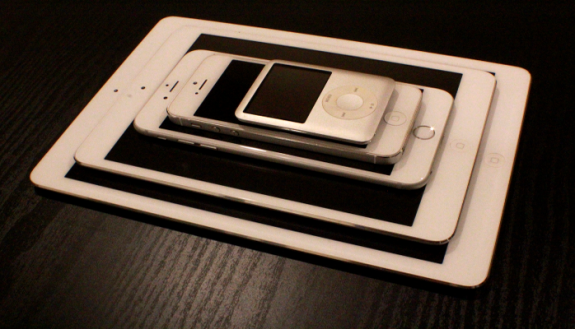
At MacWorld 2007, for the iPhone Keynote, Steve Jobs famously stated, “It’s the best iPod we’ve ever made.” In Q4 2006, iPod units sold stood at 8.73 million. In Q4 2014, iPods units sold were 2.64 million while iPhone and iPad units sold stood at 39.27 million and 12.32 million units respectively. (Source: Apple)
When Apple rolled out it’s first MP3 players, they took off by storm. The usability and innovation was eclipsing those of competitors, and sales was the measuring stick. Since then other vendors have made up some ground, but Apple still holds around ~70% of the MP3 player market share. Sure, we can debate that the age of the iPod is over; iPod accounted for just $973 million of the company’s $57.6 billion revenue in Q1 2014 (less than 2 percent of Apple sales revenue compared to 56 percent for the iPhone). Yet, it’s undeniable that Apple’s later products, especially the iPhone, has cannibalized the market share for the iPod.
Finally, on Sept. 9, 2014, Apple announced it’s retiring the palm sized iPod; the sales for this specific product had dropped by more than half in six years. Makes sense, after-all, why sell a separate product that’s the same size as the iPhone but dedicated only for music? Rather, keep the smaller MP3 players as they still have differentiation, mainly more portability.
This is a classic example of how companies must keep innovating and embracing what the consumer wants, even if it means cannibalizing their own products. Again, sales was the measuring stick with a record-breaking $74.6 billion in revenue and $18 billion in net profits for Q1 2015, toppling both its profit and revenue records set in Q1 2014.
Interestingly, with the recent launch of it’s iPhone 6 Plus with a 5.5″ screen size, some have speculated possible cannibalization of the iPad, especially the iPad mini which has a 7.9″ screen size. So, was iPhone 6 Plus a mistake? Definitely not; again, companies must listen to what the free market is telling them; there will always be a competitor to fill the demand.
Before the iPhone 6 Plus, customers who wanted a smart phone with a larger screen had to look elsewhere, and Samsung was delivering. Before the iPhone 6 Plus, especially after the 3rd generation iPhones rolled out, many friends I talked to switched from iPhone to Samsung or another vendor only because they wanted a larger screen; now that option is there for iPhone also.
Apple is not unique to this trend in the industry where consumers are demanding more in less; basically, consumers don’t want multiple devices for multiple things. Smart phones in particular have been the ultimate Swiss Army Knife, being used as MP3 players, GPS devices, pocket PCs/PDAs (if you remember these), cameras, video cameras, audio recorders, flashlights, compasses, etc.
Digital watches now have GPS, MP3 player, Internet, and, fitness and health monitoring capabilities integrated; apple has even announced a watch which is bound to shake-up the smart watch market. Stand-alone streaming media players are giving way to TVs with integrated Internet and media streaming capabilities; some companies are cannibalizing their own standalone media streaming devices to compete with competitors offering integrated devices. I have a Sony Streaming Media Player and Roku for sale, as I recently upgraded my TV with Internet and media streaming services for Netflix, Amazon Prime, HBO Go, etc. built-in.
Customers seem to be getting more demanding and have higher expectations of what technology could and should do for them. Those companies that are leading in market share today, but are afraid of change for whatever reason, will learn the hard way. Blockbuster is a classic example; once the market leader in movie rentals with 50 million members at its height, Blockbuster failed to keep innovating and failed to realize the Netflix threat and what consumers wanted; they stuck to their old and true model and led the market, for a little bit longer at least. If Blockbuster had invested into the streaming business early and stuck with it, they could have started transitioning their paying brick-and-mortar customers to subscription-based streaming customers and then scaled down their brick-and-mortar business. Instead, in 2010, Blockbuster filed for bankruptcy, and Netflix posted revenue of 2.16 billion that same year. By 2014, Netflix’s revenue was at 5.5 billion (Source: Netflix).
Today on-demand streaming services like Netflix and Amazon Prime are even challenging cable TV. Customers want to watch what they want when they want. The premium cable network, HBO, failed to realize this, and, later, eventually created an online streaming service, HBO Go, but made it available only to their subscription cable customers. In 2013, Netflix surpassed HBO in paid US subscribers at roughly 29.93 million; HBO, at that time, was estimated to have around 28.7 million subscribers. Near the end of last year, HBO finally caved to consumer demand and announced upcoming plans to launch a standalone service similar to Netflix, making its content available outside of a cable package.
Within the last decade, I’ve been amazed at the advancement in both consumer and enterprise electronics/technology. Technology is advancing at incredible speed along with consumer expectations and demands. In turn companies are pushing the envelope for innovation and taking bigger risks to not become obsolete; yes, these are exciting times. As former CEO of General Electric, Jack Welch, once stated, “Innovation is not a big breakthrough invention every time. Innovation is a constant thing. If you don’t have an innovative company coming to work every day to find a better way, you don’t have a company; you’re getting ready to die on the vine.”
Follow me on Twitter: @Humair_Ahmed



 Twitter
Twitter LinkedIn
LinkedIn Youtube
Youtube RSS
RSS